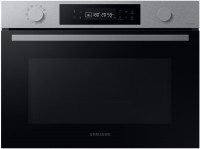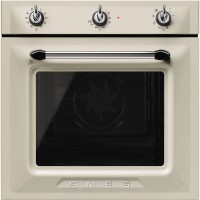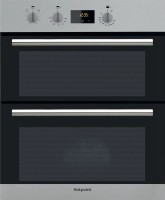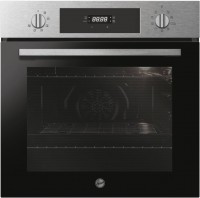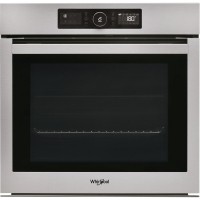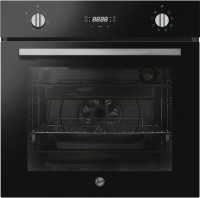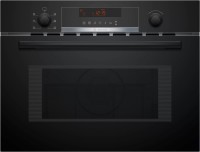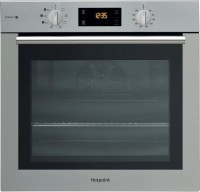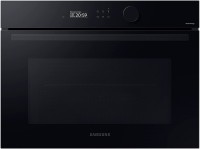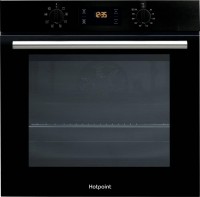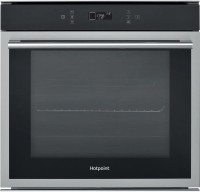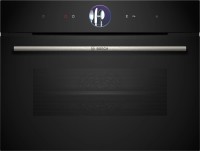Ovens AEG
All Ovens Advanced filters → |
You might be interested in
Articles, reviews, useful tips
All materials
TOP 5 affordable ovens from trusted brands
Full-size ovens from reputable manufacturers with reasonable prices

TOP 5 ovens with microwave
Compact built-in ovens that support microwave function

Pyrolysis, catalysis, hydrolysis: what is the most effective method of cleaning an oven?
Let's figure out what catalytic, pyrolytic and hydrolytic oven cleaning are and what are their advantages

Bosch oven markings
In this article, we will focus on deciphering the "names" of Bosch ovens

TOP 5 large and functional ovens
Ovens for large families and those who bake a lot

What is Sous vide technology (sous vide) and is it needed in the home kitchen
Cooking homemade dishes "under vacuum" will expand the family menu and pleasantly surprise your guests
Ovens: specifications, types
Type
— Electric. Ovens with electric heating elements. Such models are much easier and safer to install and connect than gas ones. They can be used even in the absence of gas supply (for example, in private houses not connected to a gas pipeline, high-rise buildings where gas is not supplied for security reasons, etc.). In addition, it is easier to implement specific cooking modes and other additional functions in an electric oven, and heating in such models is more ev...en. On the other hand, the power consumption of electric ovens is quite high, which means that they cannot be operated from conventional sockets, require reliable wiring, and can significantly affect your electricity bills.
— Gas. Ovens with heaters in the form of gas burners. The operation of such models, usually, is cheaper than electric ones. In addition, they heat up faster. However, the heating is less uniform. Such devices can only be installed where gas is supplied (or use replaceable gas cylinders, which is not very convenient). And installation should be carried out by gas specialists.
— Gas. Ovens with heaters in the form of gas burners. The operation of such models, usually, is cheaper than electric ones. In addition, they heat up faster. However, the heating is less uniform. Such devices can only be installed where gas is supplied (or use replaceable gas cylinders, which is not very convenient). And installation should be carried out by gas specialists.
Design
Ovens designed for installation in kitchens with a retro design. They have a specific vintage design, allowing them to fit into the appropriate interior. In terms of functionality, they do not have fundamental differences from classic ovens. However, controls based on rotary knobs and mechanical timers are most often used. At the same time, retro ovens, usually, are not cheap, since they are created mainly as designer models.
Controls
The type of control panel installed in the oven. To date, there are such options:
— Rotary knobsswitches. Controls based on classic rotary knobs, known to many users for other types of kitchen appliances — primarily classic cookers. This type of control can be found in both low-cost and advanced models: the specifics of the operation of ovens are such that many functions (both basic and additional) are conveniently controlled with rotary knobs and the...simplest mechanical controls, and a complex electronic circuits. However, rotary knobs in their pure form are not used very often today — much more often they are combined with buttons or touch controls (see below).
— Push-buttons. Push-button controls are typical of the electronic type and use complex control circuits, making this type of control suitable for models with a wide range of additional features. However, pure push-button controls, without rotary knobs, are very rare in ovens. On the one hand, for some functions, such controls are less convenient than rotary knobs; on the other hand, they are rather unusual for ovens, which can cause additional discomfort for the user.
— Touch controls. They are in many ways similar to push-buttons (see above). The main difference between touch controls and buttons is that the touch controls respond to touch, not to press. Thanks to this, using such panels is much easier. In addition, the touch sensors give the device a stylish look and are easy to clean because they do not have protruding parts. Such controls in their pure form, not combined with rotary knobs, are also quite rare. However, for several reasons, there are still much more touch controls models than push-button ones.
— Rotary knobs with push-buttons. Control panels equipped with both rotary knobs and buttons. See above for more details on both. Here we note that the combination of two types of control allows not only to combine their advantages but also provides additional convenience: some functions of the oven can be tied to rotary knobs, others to buttons, linking each function with the type of control that is optimal for it. Due to this, this option is the most common today.
— Rotary knobs with touch controls. Combined control with rotary knobs and touch controls (see above for more on both). Like the “rotary knobs with push-buttons” option (also described above), it is very convenient because each function of the oven is tied to the type of control that is optimal for it — either to the rotary knob or to the touch controls. This option is much less common, but this is not due to inconvenience but primarily to the high cost of touch controls compared to push-buttons. Accordingly, it is used mainly in models of the middle and top classes.
— Pop out knobs. A variation of the rotary knobs described above, in which the knobs can be recessed into the control panel. Usually, pop out knobs are designed to stay outside only during the direct setting of the operating mode, and for the time when the oven is not in use or works in one mode, they can be hidden. It gives the unit a neat appearance, reduces the places where dirt can accumulate and makes the front panel easier to clean. Unlike rotary knobs, pop out knobs are mainly used in electrical models.
— Pop out knobs with push-buttons. Controls combining Pop out knobs with push-buttons. Both of these types of controls are described above, and in itself, this option is almost the same as a combination of buttons with rotary knobs (also see above).
— Pop out knobs with touch controls. A variant, by the name, combines pop out knobs and touch controls. Each of these types of control is described separately above, and their combination is almost no different from the combination of rotary knobs with touch controls (also see above). Except with the correction that recessed knobs keep the number of protruding elements on the control panel to an absolute minimum.
— Rotary knobsswitches. Controls based on classic rotary knobs, known to many users for other types of kitchen appliances — primarily classic cookers. This type of control can be found in both low-cost and advanced models: the specifics of the operation of ovens are such that many functions (both basic and additional) are conveniently controlled with rotary knobs and the...simplest mechanical controls, and a complex electronic circuits. However, rotary knobs in their pure form are not used very often today — much more often they are combined with buttons or touch controls (see below).
— Push-buttons. Push-button controls are typical of the electronic type and use complex control circuits, making this type of control suitable for models with a wide range of additional features. However, pure push-button controls, without rotary knobs, are very rare in ovens. On the one hand, for some functions, such controls are less convenient than rotary knobs; on the other hand, they are rather unusual for ovens, which can cause additional discomfort for the user.
— Touch controls. They are in many ways similar to push-buttons (see above). The main difference between touch controls and buttons is that the touch controls respond to touch, not to press. Thanks to this, using such panels is much easier. In addition, the touch sensors give the device a stylish look and are easy to clean because they do not have protruding parts. Such controls in their pure form, not combined with rotary knobs, are also quite rare. However, for several reasons, there are still much more touch controls models than push-button ones.
— Rotary knobs with push-buttons. Control panels equipped with both rotary knobs and buttons. See above for more details on both. Here we note that the combination of two types of control allows not only to combine their advantages but also provides additional convenience: some functions of the oven can be tied to rotary knobs, others to buttons, linking each function with the type of control that is optimal for it. Due to this, this option is the most common today.
— Rotary knobs with touch controls. Combined control with rotary knobs and touch controls (see above for more on both). Like the “rotary knobs with push-buttons” option (also described above), it is very convenient because each function of the oven is tied to the type of control that is optimal for it — either to the rotary knob or to the touch controls. This option is much less common, but this is not due to inconvenience but primarily to the high cost of touch controls compared to push-buttons. Accordingly, it is used mainly in models of the middle and top classes.
— Pop out knobs. A variation of the rotary knobs described above, in which the knobs can be recessed into the control panel. Usually, pop out knobs are designed to stay outside only during the direct setting of the operating mode, and for the time when the oven is not in use or works in one mode, they can be hidden. It gives the unit a neat appearance, reduces the places where dirt can accumulate and makes the front panel easier to clean. Unlike rotary knobs, pop out knobs are mainly used in electrical models.
— Pop out knobs with push-buttons. Controls combining Pop out knobs with push-buttons. Both of these types of controls are described above, and in itself, this option is almost the same as a combination of buttons with rotary knobs (also see above).
— Pop out knobs with touch controls. A variant, by the name, combines pop out knobs and touch controls. Each of these types of control is described separately above, and their combination is almost no different from the combination of rotary knobs with touch controls (also see above). Except with the correction that recessed knobs keep the number of protruding elements on the control panel to an absolute minimum.
Capacity
The working capacity of the oven. The amount of food that can be cooked in the device and the amount of space required for embedding depends on this parameter.
A capacity of about 50 – 60 litres is considered quite sufficient for a family of 2 – 3 people. It is the capacity that most modern built-in ovens have. However, there are other options — modest models of 20 – 30 litres, similar in capacity to microwave ovens, large in capacity for home baking a...nd large cabinets of 100 litres or more, designed more for cafes and restaurants than for home use.
A capacity of about 50 – 60 litres is considered quite sufficient for a family of 2 – 3 people. It is the capacity that most modern built-in ovens have. However, there are other options — modest models of 20 – 30 litres, similar in capacity to microwave ovens, large in capacity for home baking a...nd large cabinets of 100 litres or more, designed more for cafes and restaurants than for home use.
Cooking temperature
The cooking temperature range allows you to understand which special tasks are subject to the oven. The lower temperature from which the oven starts heating, usually, is in the range of +30 to +50 ˚C. So, for example, the minimum heating temperature at +30 ˚C allows you to defrost products. Models with a minimum of 40 ˚C and 50 ˚C allow you to heat ready meals, heat tableware (before serving), dry...crackers, etc.
Cooking modes
Among the cooking modes, one can single out modes that are relevant for models in the role of ovens (these are grill, convection, convection with heater, double convection, rotisserie fork, temperature probe), as well as special operating modes that turn the oven into another device on the kitchen table (...microwave oven, built-in steamer and steam cooking)
— Microwave. The presence of a microwave heater in the oven, along with an electric or gas one (see "Oven"). This feature significantly expands the functionality of the device: a microwave generator is convenient for heating and defrosting food, and its use in combination with the main heater allows you to speed up the cooking time and provide better heating, especially when cooking the product as a whole piece (for example, when baking boiled pork). At the same time, such combined ovens are more expensive than conventional ones not equipped with a microwave.
— Built-in steamer. Possibility of using the oven for steam cooking. Cooking is carried out in the main chamber of the oven, and the steam comes from a special reservoir into which water is poured in advance. This method is considered more healthy than traditional cooking or frying. In addition, it often turns out to be optimal for people with dietary restrictions. However, models with steamer functions are also more expensive than usual ones.
— Steam cooking. Water is poured into a special tray at the bottom of the oven, and evaporates under the influence of high temperature, thereby steaming the dishes in the device. However, such ovens have basic capabilities and do not have a separate programme, modes, or sensors that would monitor the work and the steam cooking process itself.
— Grill. Device for cooking food using thermal radiation. The grill allows you to get dishes with a fried surface or crispy crust. However, this method of cooking is considered healthier than frying in oil. This function is especially useful in combination with a rotisserie fork (see below).
— Convection. This function implies the presence of a fan in the oven, which forcibly draws heated air through the working chamber. It ensures a more even distribution of heat than with natural (without a fan) air circulation, which has a positive effect on the heating efficiency and the quality of cooking.
– Convection with heater. The combination of convection for uniform distribution of heated air flows and an annular heater, which is located around the fan. In this cooking mode, an increase in the temperature of the air driven by the blades is ensured. This type of dry convection is more efficient as it allows the circulating air to warm up evenly faster.
— Double convection. Improved convection function (see above), in which two fans are responsible for air circulation at once. According to the manufacturers, this ensures the evenest distribution of hot air throughout the volume of the oven and, accordingly, high-quality cooking. In addition, double convection is found in models with an additional chamber — where each fan is responsible for its own oven compartment.
— Rotisserie fork. A device in the form of a fork on which pieces of meat, chicken or other food can be strung. When cooking, this fork rotates, which allows you to evenly heat the dish from all sides. In modern ovens, this function is necessarily combined with a grill (see above); other cooking methods for a rotisserie fork are of little use or do not make sense.
— Temperature probe. A device for measuring the temperature of cooked food. It looks like a thin rod with a temperature sensor at the end. With such a rod, you can measure the temperature both outside and inside the dish being prepared, determining its condition and degree of readiness. Temperature probes are especially useful when roasting meat.
— Double oven. The ability to cook two different dishes at the same time in the oven saves time — for example, you can bake meat in the upper chamber and cook cake layers in the lower one. And the role of a partition between the chambers is played by a baking sheet, which can be removed and the oven used for a total volume.
— Custom programme. Ability to create your own oven programme. Such programmes are similar to automatic ones (for more details, see “Number of automatic programmes”). However, unlike the latter, you can change them at your own discretion and save them in the oven’s memory, which gives you ample features to customize the oven to your preferences. — Defrosting. A programme for gentle defrosting of frozen foods. In this mode, the oven operates at a low intensity — so that the contents effectively thawed but, at the same time, did not bake. Data on the defrosting time required for a certain amount of a certain product is usually given in the instructions for use.
— Microwave. The presence of a microwave heater in the oven, along with an electric or gas one (see "Oven"). This feature significantly expands the functionality of the device: a microwave generator is convenient for heating and defrosting food, and its use in combination with the main heater allows you to speed up the cooking time and provide better heating, especially when cooking the product as a whole piece (for example, when baking boiled pork). At the same time, such combined ovens are more expensive than conventional ones not equipped with a microwave.
— Built-in steamer. Possibility of using the oven for steam cooking. Cooking is carried out in the main chamber of the oven, and the steam comes from a special reservoir into which water is poured in advance. This method is considered more healthy than traditional cooking or frying. In addition, it often turns out to be optimal for people with dietary restrictions. However, models with steamer functions are also more expensive than usual ones.
— Steam cooking. Water is poured into a special tray at the bottom of the oven, and evaporates under the influence of high temperature, thereby steaming the dishes in the device. However, such ovens have basic capabilities and do not have a separate programme, modes, or sensors that would monitor the work and the steam cooking process itself.
— Grill. Device for cooking food using thermal radiation. The grill allows you to get dishes with a fried surface or crispy crust. However, this method of cooking is considered healthier than frying in oil. This function is especially useful in combination with a rotisserie fork (see below).
— Convection. This function implies the presence of a fan in the oven, which forcibly draws heated air through the working chamber. It ensures a more even distribution of heat than with natural (without a fan) air circulation, which has a positive effect on the heating efficiency and the quality of cooking.
– Convection with heater. The combination of convection for uniform distribution of heated air flows and an annular heater, which is located around the fan. In this cooking mode, an increase in the temperature of the air driven by the blades is ensured. This type of dry convection is more efficient as it allows the circulating air to warm up evenly faster.
— Double convection. Improved convection function (see above), in which two fans are responsible for air circulation at once. According to the manufacturers, this ensures the evenest distribution of hot air throughout the volume of the oven and, accordingly, high-quality cooking. In addition, double convection is found in models with an additional chamber — where each fan is responsible for its own oven compartment.
— Rotisserie fork. A device in the form of a fork on which pieces of meat, chicken or other food can be strung. When cooking, this fork rotates, which allows you to evenly heat the dish from all sides. In modern ovens, this function is necessarily combined with a grill (see above); other cooking methods for a rotisserie fork are of little use or do not make sense.
— Temperature probe. A device for measuring the temperature of cooked food. It looks like a thin rod with a temperature sensor at the end. With such a rod, you can measure the temperature both outside and inside the dish being prepared, determining its condition and degree of readiness. Temperature probes are especially useful when roasting meat.
— Double oven. The ability to cook two different dishes at the same time in the oven saves time — for example, you can bake meat in the upper chamber and cook cake layers in the lower one. And the role of a partition between the chambers is played by a baking sheet, which can be removed and the oven used for a total volume.
— Custom programme. Ability to create your own oven programme. Such programmes are similar to automatic ones (for more details, see “Number of automatic programmes”). However, unlike the latter, you can change them at your own discretion and save them in the oven’s memory, which gives you ample features to customize the oven to your preferences. — Defrosting. A programme for gentle defrosting of frozen foods. In this mode, the oven operates at a low intensity — so that the contents effectively thawed but, at the same time, did not bake. Data on the defrosting time required for a certain amount of a certain product is usually given in the instructions for use.

